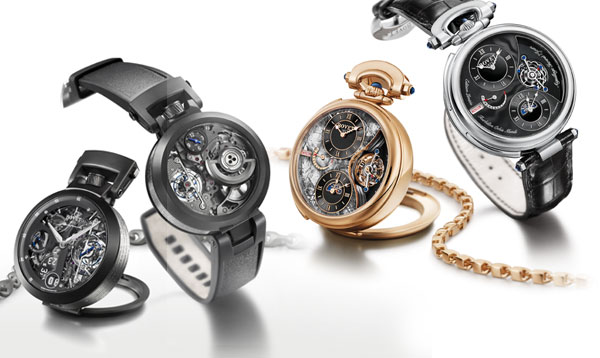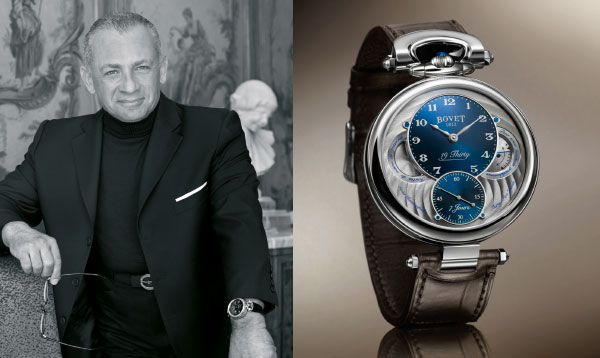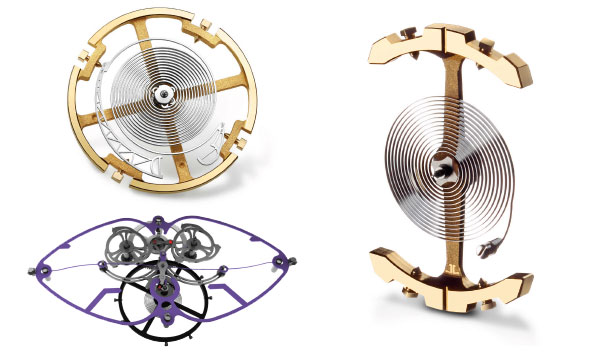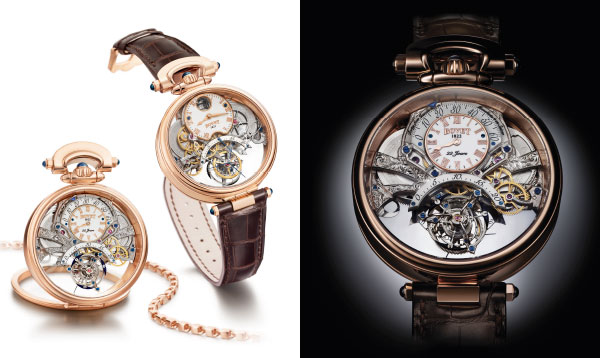
Bovet by Pininfarina Tourbillon OTTANTA®
Movement : 80 seconds self-winding tourbillon, 80 hours power-reserve, reversed hand-fitting Case : AMADEO® convertible (reversible wristwatch, table clock, pocket watch). Titanium (G5) and stainless steel DLC DIAMETER : 45mm Functions : Hours, minutes, sectorial seconds indicated by rotating crown, big date, power reserve, reversed hours hand, 80 seconds tourbillon Dial : Transparent crystal with metal axis Strap : Rubber with suede interior, titanium chain Water resistance : 10Atm- 100m
Tourbillon Orbis Mundi® with reversed hand-fitting Movement : mechanical Hand-wound 13BM06AI with 7 hour power reserve, 21’600 vibrations per hour Case : AMADEO® Convertible (wristwatch, table clock, pocket watch), 18K red or white gold, 18 red or white gold chain diameter : 46mm Functions : main time zone: hours, minutes, seconds on the tourbillon. Second time zone: (hours & minutes) city indicator, day & night indicator, power reserve, reserved hand hand-fitting Dial : silver meteorite with black polished ebamel sub dials Strap : full-skin alligator leather with 18K red or white gold pin buckle Water resistance : 30m
Thus the essence of the partnership resides in the decoration of this automatic tourbillion. Bovet provided its exceptional expertise in mechanical architecture and its mastery of multiple,age-old and modern decorative techniques, while the latter contributes its virtuosity in terms of design, elegance and colour associations.
In close collaboration with their counterparts at Pininfarina, the design team at Dimier 1738 (Bovet sistership company also owned by Bovet’s owner, Mr Raffy) developed exterior parts and a “motorization” that merge into a single, coherent entity, managing to overcome considerable obstacles to create an overall effect of clarity and depth despite the extreme complexity of the movement.Experts in the art of showing materials and volumes to optimal effect, Pininfarina designers suggested using the widest possible range of nuances of grey, sensing that the adoption of a monochrome approach would have the effect of smoothing volumes while recourse to different colours would prove aesthetically unappealing. To achieve unsurpassed refinement in terms of decoration, the engineers and craftsmen of Dimier 1738 analysed 56 decorative samples and shades of grey and anthracite. Many of these were specially designed and developed for this occasion. All were rigorously tested to guarantee technical and aesthetic results that are unalterable over time.In a final detail that symbolises the virtuosity of Dimier 1738 craftsmen, the surfaces of bridges on either side of the tourbillon cage feature circular bipolar Clous de Paris decorative work, a feat seemingly impossible to achieve until now. As a tribute to the 80th anniversary of Pininfarina, the technical designers of Dimier 1738, created a tourbillon which makes one complete revolution in exactly 80 seconds, whereas traditionally this operation lasts one minute. The development of this new calibre and every aspect of the design and production of its 514 constituent parts is the in-house work of Dimier 1738’s engineers and watchmakers. It is housed in a convertible case, meaning it can be worn on the wrist with either of its two faces displayed, or combined with a titanium chain – also exclusively designed – for use as a pocket watch, or deployed as a miniature table clock. All of this is possible by means of simple manipulations, without tools, according to the needs or mood of its owner. Naturally the co-signed Ottanta® Tourbillon is produced in a limited edition of 80 pieces. Even before this masterpiece reached maturity, the enthusiasm and passion that drive Mr Pascal Raffy and Mr Paolo Pininfarina led them to conclude a long-term collaboration giving rise to other creations (at the rate of one per year), like in 2011 the Chronograph Cambiano Edition 2011.
Following the example of its predecessor, from which it inherits certain aesthetic codes such as the oscillating weight and screws, the Chronograph Cambiano edition 2011 presents a varied topography united by a succession of curves and sharp angles. Architecturally rich, it is structured with contrasting finishes and surface treatments selected with meticulous attention to detail. Its superbly proportioned convertible case allows the timepiece to be used as a wristwatch, miniature clock, pocket watch or sports counter. Shaped to resemble an accelerator, its push-pieces are arranged symmetrically on either side of the bow at 11 o’clock and 1 o’clock in keeping with BOVET’s customary aesthetic codes. This positioning ensures perfect ergonomics regardless of which case configuration is used. For optimal functionality and perfect clarity, chronograph and time indications are displayed separately. Chronograph functions are therefore arranged on the dial’s horizontal axis, with the seconds hand naturally in the centre, the minute counter at 9 o’clock and the hour counter at 3 o’clock. Time indications meanwhile occupy the dial’s vertical axis, with hours and minutes in the centre, seconds at 6 o’clock and large date at 12 o’clock. In addition, to eliminate any possible confusion, the chronograph hands are blued, while time indications are shown by rhodium-plated hands. Perfectly balanced, the small seconds-hand with its stylised design is evocative of the motor car and the world of watchmaking.

The Dimier collection is the only one in the Bovet collection that does not have a crown positioned at 12 o’clock and does not feature the brand’s traditional bow. It was launched in 2007 and named in tribute to the artisans of the eponymous Manufacture bought up a year earlier by Pascal Raffy, already sole owner of Bovet since 2001.
The collection comprises timepieces driven by exclusive tourbillon movements and complications developed by the Dimier Manufactory, like the brand new Dimier Récital 0. Although it is the 8th model in this collection, this model was code-named “0” because of its indications similar to those of the Récital 1. It marks a return to basics and the fundamental values of the tourbillon envisaged by Pascal Raffy when he assigned this project to Dimier’s designers and master watchmakers. Only a power reserve indicator (7 days) is added to the display of hours and minutes in the centre and of seconds shown by a triple seconds hand carried by the upper pivot of the tourbillon cage.
Research and development of this new timepiece focused mainly on the movement’s architecture. The threequarter bridges and bottom plate reveal the tourbillon cage suspended between two “cradle” shaped bridges. The cage has a 14mm diameter corresponding to roughly half the total diameter of the movement. These dimensions guarantee exceptional quality and consistency of timing. The absence of a dial reveals the beauty of the movement’s innovative design. Proposed in diameters of 41mm and 45mm, the case is also available with a bezel set with baguette diamonds. In total, eight different variants are available to meet the specific requirements of every collector. Although it has not been the object of numerous patent registrations, not having served as the test lab for a revolutionary new alloy, nor featuring a vast number of complications, the architecture, aesthetic appeal and remarkable performances of the Récital 0 make it a unique and genuinely innovative timepiece. This new reference single-handedly embodies collectors’ legitimate wish to be offered creations in which over-the-top excess is superseded by the fundamental values of Haute Horlogerie as they were defined by the pioneers of time measurement over two centuries ago.
Fleurier AMADEO® “Mille Fleurs”
Case : AMADEO® Convertible (wristwatch, table clock, pendant watch) in 18-carat red or white gold Diameter : 39mm Movement : mechanical self-winding movement (caliber 11BA13 with 72h power reserve) Dial : hand-painting flower on mother-of-pearl with diamond indexes Functions : hours, minutes Water-resistance : 30m Bracelet : Alligator ful-skin
Dimier Récital 0
Case : 18-carat red or white gold (set with baguette-cut diamonds or not) Diameter : 41 or 14mm Movement : mechanical hand-wound movement (Dimier caliber with 7 day power reserve) Dial : open openwork Functions : hours, minutes & seconds on tourbillon, power reserve indicator Water-resistance : 30m Bracelet : alligator full-skin leather




